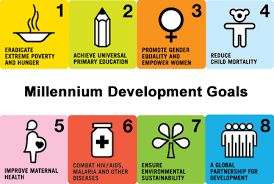
The Millennium Development Goals (MDGs) were eight time-bound goals providing concrete, numerical benchmarks for tackling extreme poverty in its many dimensions.
The MDGs included goals and targets on income poverty, hunger, maternal and child mortality, disease, inadequate shelter, gender inequality, environmental degradation and the Global Partnership for Development.
Adopted by world leaders in the year 2000 with the attention of being achieved by 2015, the MDGs were both global and local, tailored by each country to suit specific development needs.
The eight MDGs below in turn broke down into 21 quantifiable targets that were measured by 60 indicators.
- Goal 1: Eradicate extreme poverty and hunger
- Goal 2: Achieve universal primary education
- Goal 3: Promote gender equality and empower women
- Goal 4: Reduce child mortality
- Goal 5: Improve maternal health
- Goal 6: Combat HIV/AIDS, malaria and other diseases
- Goal 7: Ensure environmental sustainability
- Goal 8: Develop a Global Partnership for Development
In late 2018, Our World in Data claimed that the results are in: now for the first time we can look back and see how the world actually did in terms of delivering the MDGs. This is only possible now - three years after the end of the MDG era in 2015 - as it often takes several years until the relevant data is available at a global level. Early assessments had to rely on extrapolations of earlier trends.
See also:


